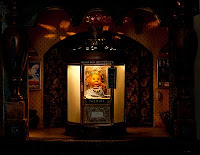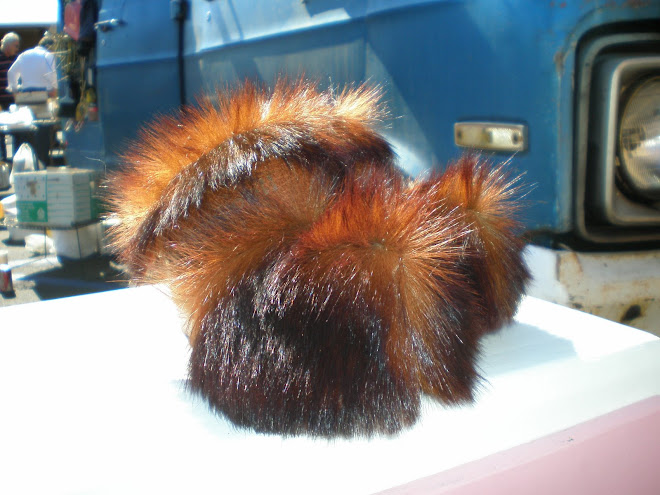Dioramas as artistic product have a pedigree that may extend to sixth century Japan and the artform known as Bonkei, and nowadays as Tatebanko. According to Wikipedia, Bonkei is Japanese for "tray landscape" and "is a three-dimensional depiction of a landscape in miniature, portrayed using mainly dry materials like rock, papier-mâché or cement mixtures, and sand in a shallow tray." And, of course, in the last 50 years, we have Marcel Duchamp's Étant donnés, a diorama that took Duchamp 20 years to make and was the primary reason for him absconding from his self-imposed chess retirement.
The dioramas sculpted by Armando Arreola and currently on view at Ave 50 Studio in Highland Park draw viewers into them like some mystical well, or forbidden keyhole. Viewers peer into the tableaus with the senses, and are amply awarded by meticulous, wicked props which easily prompts viewers to make their own narratives. Armando is also able to construct a tiny dialect from the seemingly haphazard repetition of theaters, cinemateques, and mesmerists. The matted hair of the dolls make it appear as if the dolls have mange or some other medieval scourge. You could even say that Arreola's scenes are the frozen shards of apocalyptic doll events.
Arreola's sculptures are part dioroma, part tableau, and yet all overwhelmingly cinematic. The exhibition, aptly titled Magic Circle,is a celebration of magicians, and their retinues, cinephiles, and their haunts, and theater patrons. It's aim is to show the meditative and baroque flair of the artist, but it is also nostalgic like the work of Joseph Cornell and bulging with whimsy like the works of Tracey Snelling. I think it would be safe to say that the characters in the sculptures look like recycled dolls, and run the gamut of physiognomies.

Photo credit: Martha Benedict
Some of the sculptures depict dolls with dirty faces dressed as seers and mesmerists holding seances in dark parlors illuminted by ambient light and the sheen of turqoise ceremonial robes. A swami in matching turqoise turban is about to enact the protocols for calling the spirit world. On his neck: a dazzling star pendant; and, on top of his turban: a decadent feather that makes the doll look more like a gendarme than a palm reader/grifter.

Photo credit: Martha Benedict
Another piece depicts three dolls engaged in a bout of vaudevillian sword swallowing. As a means of titillating the crowd, the two dolls that are assisting hold up an X-Ray to prove the sword swallowing is legit. Audience members look on with bulbous, matted hair. A common element in these sculptures is a frame within a frame architecture, so this particular piece contains the symbols of the spiritual arts in several of its frames.

Photo credit: Martha Benedict
While other sculptures find dolls hanging in ticket sales booths awaiting the second coming of Goddard. As I've mentioned before, the wild card in many of these sculptures is the cinematic aura that Arreola is able to concoct. For example, in the doll sitting in the ticket buying kiosk could be right out of a little cinemateque in Montmarte, but the gigantic doll face and accompanying follicle plummage give the scene a mordant, dreamy quality.
At first sight, I was struck how much these sculptures reminded me of a filthy confessional booth teeming with Hail Mary's. Because the viewer has to peer into them, I was drawn to the immediate sense of intimacy and play the artist was able to convey. In 1822 Louis Jacques Mandé Daguerre, the guy who would eventually invent the process of photography, opened the Diorama theater in Paris. He entertained crowds of people by animating gigantic landscape and cathedral representations by changing the light source.
Arreola's sculptures change the light source of approach for dioramas. The people depicted in them can be grotesque, apocalyptic dolls, and the tableaus can be esoteric, nuanced tales particular to no one and thus everyone. "Circulo Magico" by Armando Arreola opened on February 12 and will run until March 6, 2011 at Ave 50 Studio, Inc. in Highland Park. You should see these immaculate, delicate sculptures before Ave 50 progresses to its next exhibition.
References:
Westbrook, Lindsey. The 'Art of Diorama' at Bedford Gallery. Artweek. 39 no7 S 2008.

.png)

No comments:
Post a Comment